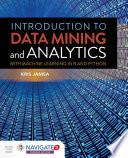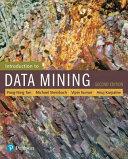
Introduction to Data Mining and Analytics
Data Mining and Analytics provides a broad and interactive overview of a rapidly growing field. The exponentially increasing rate at which data is generated creates a corresponding need for professionals who can effectively handle its storage, analysis, and translation.
- ISBN 13 : 1284180905
- ISBN 10 : 9781284180909
- Judul : Introduction to Data Mining and Analytics
- Pengarang : Kris Jamsa,
- Kategori : Computers
- Penerbit : Jones & Bartlett Learning
- Bahasa : en
- Tahun : 2020
- Halaman : 687
- Google Book : http://books.google.co.id/books?id=1VPODwAAQBAJ&dq=intitle:Data+Mining&hl=&source=gbs_api
-
Ketersediaan :
Data Mining and Analytics provides a broad and interactive overview of a rapidly growing field.




